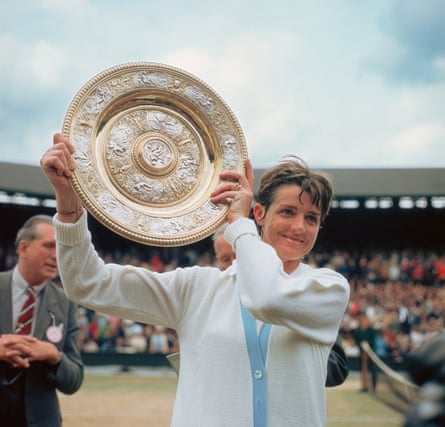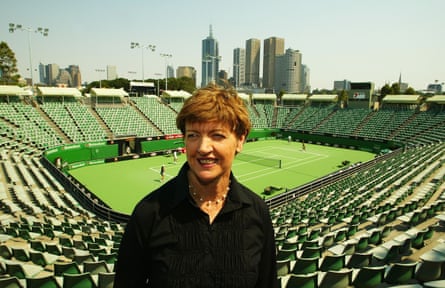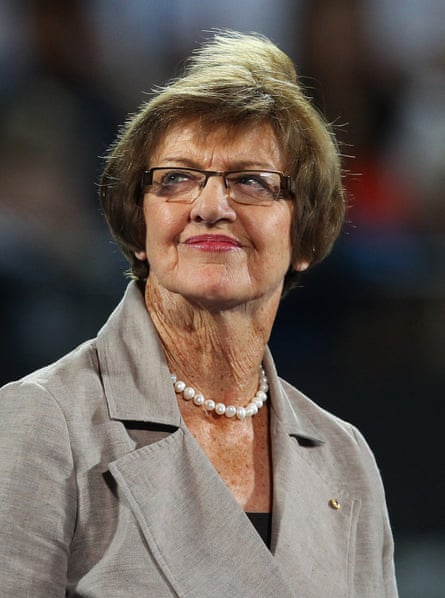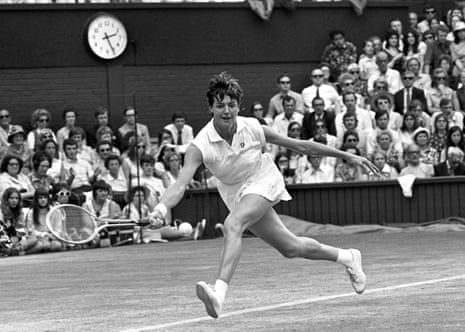Margaret Court was the most glittering example of Australia’s domination of world tennis in the 1960s and 70s – a prolonged period of supremacy in which a murderer’s row of superstar players with iconic, instructive nicknames like Rocket, Muscles and Newk took all before them.
It was a time when Australia’s sun-blessed climate, abundance of tennis facilities and lack of the stifling class systems that held the sport back in other countries, seemed destined to ensure world-beating talent would flourish forever. Even then, in the fattest of times, it was beyond comprehension that the country would ever produce a female champion to rival Court. She was a living legend among mere champions.
At times like this past week, as Court determinedly administered upper cut after crushing right cross to her own reputation, it pays to note her more noble achievements before they’re forgotten entirely, for Court’s record 24 grand slam singles titles (and 64 including doubles) are for generations of Australians little more than fading facts from dusty almanacs.
From her late teens to her mid-30s, through marriage, multiple retirements and the birth of children, Court acquired a trophy collection of staggering proportions: 11 Australian Open singles crowns, five US Open titles and as many at Roland Garros, three on the lawns of Wimbledon.
Though fame and celebrity never rested easily on her shoulders, in the throes of competition she was always a picture of quiet determination – scrupulously fair, dignified and modest, the embodiment of Australia’s outdoorsy, can-do image of her times.

If Billie Jean King – Court’s on- and off-court sparring partner since the 1960s – was the reformist whose relentless pursuit of a better deal for women brought true equality to the sport, it was Court who paved the way for women to embrace power and physicality long before the likes of Amelie Mauresmo and Serena Williams, not just beating but dominating opponents.
The bedrock of Court’s remarkable success was a compelling mix of single-mindedness and those imposing physical gifts. Height, reach (it was often said Court’s arms were three inches longer than the average woman of her size, which earned her the nickname The Arm) and power did for most opponents. “A superbly athletic animal,” is how Sports Illustrated’s Gwilym Brown termed it, calling Court “the physical equal of a great many men”.
Between 1960 and 1973 she triumphed in 929 of 1,003 matches, racking up 61 major titles and her remarkable grand slam of 1970.
Yet for all that, even before this week’s detour into tabloid ignominy, or the near-identical imbroglio of 2012, Court was, in her own words, “an anonymous champion” and a little-loved one. “I don’t think the younger people today really know what I have done,” she told Steve Flink in 2012. “Personally it doesn’t affect me. It is probably a bit sad for the history of the game.”
Throwing a hand grenade into a crowded room
To provide context for Court’s most lurid and provocative statements in the past three decades generally, and the last week particularly, one might start by perusing any of her three colourful autobiographies, published in 1965, 1975 and 2016, or Barbara Oldfield’s 1993 effort A Winning Faith: the Margaret Court Story – unique in the realm of Australian sports biographies for being written by an individual who claimed to have experienced religious salvation at the healing hands of her subject.
If there is a common theme within the Court literary oeuvre, it’s the stubborn immovability of her opinions. Another is how acutely aware she has always been of the impact of her words.

In Court’s latest book, during a passage in which she outlines her strident opposition to same-sex marriage, she also makes clear how well she understands the interplay between the interests of journalists eager for a contentious, click-baiting quote, and her own in promoting her ministry. “It is undeniable I was – am – good copy,” Court writes.
And then this, on the calculated provocations of 2011, which led to the first calls for Margaret Court Arena to be renamed: “My statement was akin to pulling the pin on a hand grenade and throwing it into a crowded room.”
One of the most astute observations made in the wake of Court’s most recent dive-bomb into public debate was by the cricket writer and high profile transgender Australian Cate McGregor, when the latter pointed to Court’s flair for publicity. “The pile-on last week strategically helped her,” McGregor told the ABC’s The Drum, “It gave prominence to her views and it rendered her a victim. You can kick us (the LGBTI community) to death to the applause of the mainstream media and ramp up solicitations for money, as I saw her acolytes doing on Christian radio the other day, and it’s frankly sick-making.”
Right now, smack bang in the middle of the website for Court’s Victory Life Centre, above even Court’s photo and biography, is a link to donate. In her latest book, Court claims a member of her congregation once handed her a cheque for $237,000. In another anecdote, a visiting American pastor promises a $50,000 donation in order to solicit smaller $1,000 donations from members of the congregation, enough in that instance for the deposit on a new property. No one knows the precise size of the market for Court’s wares, but it certainly exists.
‘God hath not given me the spirit of fear’
Court’s overt displays of faith shaped her enduring post-1970s status as an unloved champion of Australian sport, always a determinedly secular field.
Standing out in newspaper and magazine profiles of Court in the latter stages of her playing career are colourful accounts of her spiritual awakening – all arched gates, Jesuit monasteries and electric shocks through the fingertips (“I knew I had the gift of healing”). An Australian world champion who speaks in tongues? “Only a strong minded-woman would risk the jibes that these declarations are likely to attract,” was the verdict of Tennis magazine in 1976. The same year, Kooyong tennis club removed Court’s framed picture from its gallery of world stars. The die was set: even standing in the winner’s circle, Margaret Court was an outsider.
It was in 1979 – in the scripture of 2 Timothy 1:7 – that Court found the personal salvation she says she had ached for, and a cure to the physical and emotional ailments that made a misery of her post-playing life. “For God hath not given me the spirit of fear, but of power, and of love and of a sound mind...” For a time, those were the only words Court could commit to memory. As born-again Christian tales go, it was almost too great a cliche.
A central tenet of Court’s particular brand of faith is living by a quite literal interpretation of, in her words, “the Word of God”. “I believe implicitly in what the Bible tells me,” Court said in 2016. “I do not cherry pick to be popular. God has made his feelings clear, and they are my feelings, too.”

Overlooked during her current evisceration in the court of public opinion, and in Court’s cries of injustice and persecution, is the fact that for a purveyor of such divisive opinions she has actually had a charmed run. In 1970, Court kicked things off by praising South Africa’s apartheid policy (“South Africans have this thing better organised than any other country, particularly America,” she said. “I love South Africa. I’ll go back there any time.”), for which she received very little lasting scrutiny.
Her 1990 comments about Martina Navratilova (“a great player but I’d like someone at the top who the younger players can look up to. It’s very sad for children to be exposed to homosexuality. Martina is a nice person. Her life has just gone astray”), and her suggestion that lesbians were ruining tennis, drew international attention, but never went close to defining her image in Australia.
Court’s most fascinating battles on and off court have been with King, disparaged in 1975’s Court on Court as a bad sport whose outspoken feminism and public revelations about an abortion diminished her greatly in Court’s estimation. Yet when Melbourne Park’s centre court was renamed the Rod Laver Arena in 2002, it was King who argued that it should have been Court’s name on the rafters instead.
It was also King who stepped in to defend Court during the 2012 imbroglio, again amid calls to rename the arena. “Get rid of her for that?” King said. “Because you don’t agree with her? Are you kidding? Please. She deserves it. She’s a great player.”
A great player, yes, but for better or worse, Court is now the principal architect of her own image. “All my life I’ve believed you must tell the truth,” Court said last year. “Hold on to your beliefs, no matter how unpopular, no matter if saying your piece is going to get you in trouble.”

Comments (…)
Sign in or create your Guardian account to join the discussion